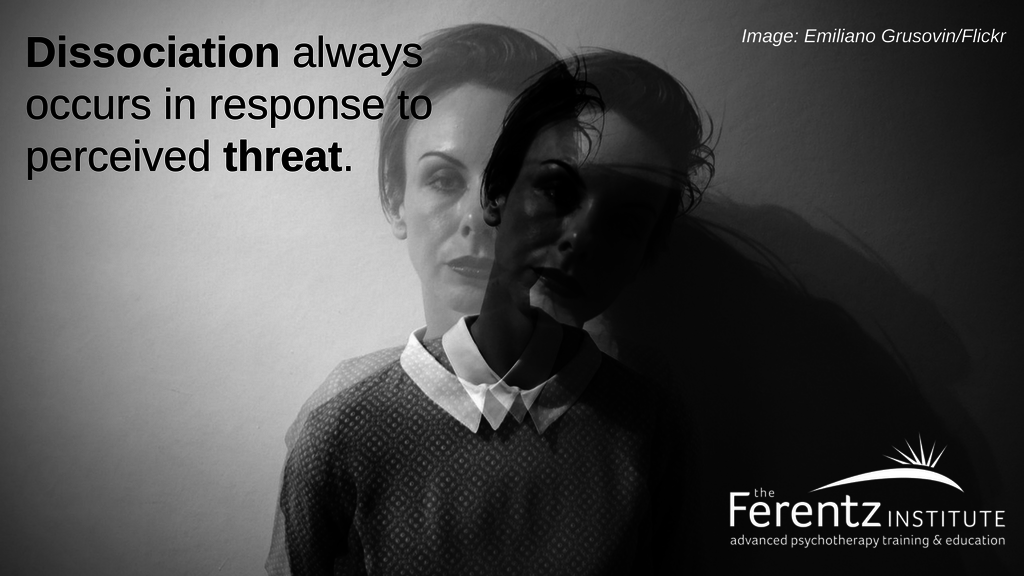
I’m often asked by clinicians how to best handle that challenging moment in therapy when a client suddenly “zones out” or “checks out.” When that occurs the conversation stops, the client breaks eye contact and stares off into space, and it’s clear that they are no longer connected to us or engaged in the process. Well-meaning therapists often quietly and patiently wait for however long it takes for the client to “come back.” They’re concerned that if they interrupt the zoning out it will feel abrupt or disrespectful to the client. They are even hesitant about acknowledging the dissociative episode afterwards for fear that it will make the client too self-conscious or evoke feelings of embarrassment or shame. Although it is important to be gentle and compassionate, ignoring the dissociation won’t help clients move forward in their healing.
Keep in mind that dissociation always occurs in response to perceived threat. Oftentimes, the client’s sense of threat is completely subjective; there is nothing objectively unsafe about the situation or the interpersonal interaction. And yet, if the client feels the need to mentally escape, it means they are feeling unsafe. Therefore, identifying and understanding the potential triggers as well as knowing how to intervene and re-ground the client become necessary steps in helping to restore a sense of safety to therapy and the therapeutic relationship. Since dissociation is not an arbitrary response, it always helps to put the dissociative reaction in context. Consider the following questions when assessing for triggers:
- What were you and the client just talking about?
- Were there any external sensory cues such as a loud noise, a certain scent, or a shift in l lighting that could be stimuli associated with a prior unsafe scenario?
- What specific emotions was the client experiencing right before they zoned out?
- What were the thoughts or visual images that occurred right before they checked out?”
- What kind of body sensations were present?
The experience of being triggering is simultaneously followed by physical harbingers that signal the beginning of zoning out. It helps clients to understand how their bodies alert them to the onset of their dissociative process as this creates the potential opportunity to intervene and short-circuit it before it becomes full-blown. Consider the following symptoms when identifying physical cues:
- A loss of peripheral vision, replaced with “tunnel vision.”
- A specific kind of headache.
- Feeling “darkness” is encompassing them.
- No longer hearing what is being said.
- A sense of “floating” or dizziness.
- The sense that things around them are moving further away from them.
- An inability to move arms or legs.
In addition to the identification of triggers and their physical harbingers, it’s equally important to offer some psychoeducation regarding the freeze response. Help your client to understand the paradox that the necessary and creative strategy they used to cope with and survive in the past is the very same strategy that now re-traumatizes. Being a deer in the headlights means they can’t use their voice, formulate an escape strategy, or advocate for their best interests. In the present, dissociation perpetuates helplessness and disempowerment, and ironically, is usually an unnecessary response. In the clinical tips below, you’ll find some simple strategies that can help clients re-ground.
Given the fact that mentally escaping has felt like a lifelong necessary survival strategy, it’s important to reassure clients that you can’t and won’t take their dissociative process away from them. Once you’ve identified the triggers and physical harbingers introduce the concept of choice. When they are about to dissociate, clients can ask themselves if it’s in their best interest to zone out or if they would be more empowered If they stayed grounded and present. The following simple strategies can help with grounding:
- Aromatherapy
- Holding an object that is warm or cold
- Tuning in to textures or the weight of an object
- Standing up and moving, swinging arms and legs
- Listening to soothing music
- Using a visual image that evokes safety and calm
- Saying out loud what they see and hear in their surroundings
Check out The Ferentz Institute’s April 11 training, Master Class Consultations – Working With Dissociative Disorders, to learn even more valuable information surrounding the treatment of dissociation.

